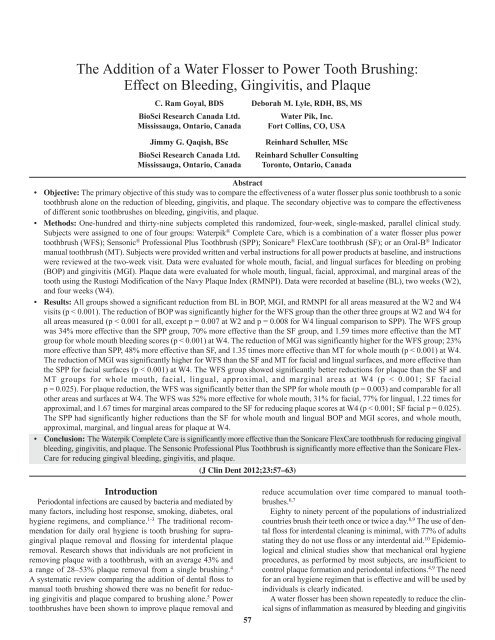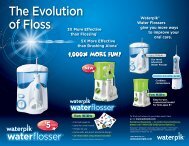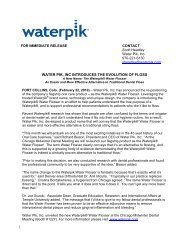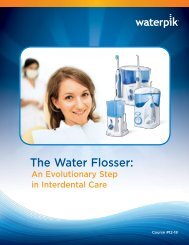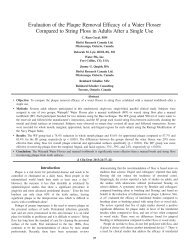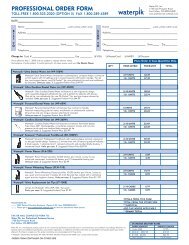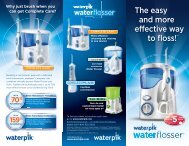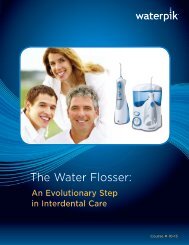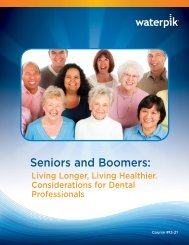Addition of Water Flosser to Power Tooth Brushing: Effect ... - Waterpik
Addition of Water Flosser to Power Tooth Brushing: Effect ... - Waterpik
Addition of Water Flosser to Power Tooth Brushing: Effect ... - Waterpik
You also want an ePaper? Increase the reach of your titles
YUMPU automatically turns print PDFs into web optimized ePapers that Google loves.
The <strong>Addition</strong> <strong>of</strong> a <strong>Water</strong> <strong>Flosser</strong> <strong>to</strong> <strong>Power</strong> <strong>Tooth</strong> <strong>Brushing</strong>:<br />
<strong>Effect</strong> on Bleeding, Gingivitis, and Plaque<br />
C. Ram Goyal, BDS Deborah M. Lyle, RDH, BS, MS<br />
BioSci Research Canada Ltd.<br />
<strong>Water</strong> Pik, Inc.<br />
Mississauga, Ontario, Canada Fort Collins, CO, USA<br />
Jimmy G. Qaqish, BSc<br />
BioSci Research Canada Ltd.<br />
Mississauga, Ontario, Canada<br />
Reinhard Schuller, MSc<br />
Reinhard Schuller Consulting<br />
Toron<strong>to</strong>, Ontario, Canada<br />
Abstract<br />
• Objective: The primary objective <strong>of</strong> this study was <strong>to</strong> compare the effectiveness <strong>of</strong> a water flosser plus sonic <strong>to</strong>othbrush <strong>to</strong> a sonic<br />
<strong>to</strong>othbrush alone on the reduction <strong>of</strong> bleeding, gingivitis, and plaque. The secondary objective was <strong>to</strong> compare the effectiveness<br />
<strong>of</strong> different sonic <strong>to</strong>othbrushes on bleeding, gingivitis, and plaque.<br />
• Methods: One-hundred and thirty-nine subjects completed this randomized, four-week, single-masked, parallel clinical study.<br />
Subjects were assigned <strong>to</strong> one <strong>of</strong> four groups: <strong>Water</strong>pik ® Complete Care, which is a combination <strong>of</strong> a water flosser plus power<br />
<strong>to</strong>othbrush (WFS); Sensonic ® Pr<strong>of</strong>essional Plus <strong>Tooth</strong>brush (SPP); Sonicare ® FlexCare <strong>to</strong>othbrush (SF); or an Oral-B ® Indica<strong>to</strong>r<br />
manual <strong>to</strong>othbrush (MT). Subjects were provided written and verbal instructions for all power products at baseline, and instructions<br />
were reviewed at the two-week visit. Data were evaluated for whole mouth, facial, and lingual surfaces for bleeding on probing<br />
(BOP) and gingivitis (MGI). Plaque data were evaluated for whole mouth, lingual, facial, approximal, and marginal areas <strong>of</strong> the<br />
<strong>to</strong>oth using the Rus<strong>to</strong>gi Modification <strong>of</strong> the Navy Plaque Index (RMNPI). Data were recorded at baseline (BL), two weeks (W2),<br />
and four weeks (W4).<br />
• Results: All groups showed a significant reduction from BL in BOP, MGI, and RMNPI for all areas measured at the W2 and W4<br />
visits (p < 0.001). The reduction <strong>of</strong> BOP was significantly higher for the WFS group than the other three groups at W2 and W4 for<br />
all areas measured (p < 0.001 for all, except p = 0.007 at W2 and p = 0.008 for W4 lingual comparison <strong>to</strong> SPP). The WFS group<br />
was 34% more effective than the SPP group, 70% more effective than the SF group, and 1.59 times more effective than the MT<br />
group for whole mouth bleeding scores (p < 0.001) at W4. The reduction <strong>of</strong> MGI was significantly higher for the WFS group; 23%<br />
more effective than SPP, 48% more effective than SF, and 1.35 times more effective than MT for whole mouth (p < 0.001) at W4.<br />
The reduction <strong>of</strong> MGI was significantly higher for WFS than the SF and MT for facial and lingual surfaces, and more effective than<br />
the SPP for facial surfaces (p < 0.001) at W4. The WFS group showed significantly better reductions for plaque than the SF and<br />
MT groups for whole mouth, facial, lingual, approximal, and marginal areas at W4 (p < 0.001; SF facial<br />
p = 0.025). For plaque reduction, the WFS was significantly better than the SPP for whole mouth (p = 0.003) and comparable for all<br />
other areas and surfaces at W4. The WFS was 52% more effective for whole mouth, 31% for facial, 77% for lingual, 1.22 times for<br />
approximal, and 1.67 times for marginal areas compared <strong>to</strong> the SF for reducing plaque scores at W4 (p < 0.001; SF facial p = 0.025).<br />
The SPP had significantly higher reductions than the SF for whole mouth and lingual BOP and MGI scores, and whole mouth,<br />
approximal, marginal, and lingual areas for plaque at W4.<br />
• Conclusion: The <strong>Water</strong>pik Complete Care is significantly more effective than the Sonicare FlexCare <strong>to</strong>othbrush for reducing gingival<br />
bleeding, gingivitis, and plaque. The Sensonic Pr<strong>of</strong>essional Plus <strong>Tooth</strong>brush is significantly more effective than the Sonicare Flex-<br />
Care for reducing gingival bleeding, gingivitis, and plaque.<br />
(J Clin Dent 2012;23:57–63)<br />
Introduction<br />
Periodontal infections are caused by bacteria and mediated by<br />
many fac<strong>to</strong>rs, including host response, smoking, diabetes, oral<br />
hygiene regimens, and compliance. 1-3 The traditional recommendation<br />
for daily oral hygiene is <strong>to</strong>oth brushing for supra -<br />
gingival plaque removal and flossing for interdental plaque<br />
removal. Research shows that individuals are not pr<strong>of</strong>icient in<br />
removing plaque with a <strong>to</strong>othbrush, with an average 43% and<br />
a range <strong>of</strong> 28–53% plaque removal from a single brushing. 4<br />
A systematic review comparing the addition <strong>of</strong> dental floss <strong>to</strong><br />
manual <strong>to</strong>oth brushing showed there was no benefit for reducing<br />
gingivitis and plaque compared <strong>to</strong> brushing alone. 5 <strong>Power</strong><br />
<strong>to</strong>othbrushes have been shown <strong>to</strong> improve plaque removal and<br />
57<br />
reduce accumulation over time compared <strong>to</strong> manual <strong>to</strong>othbrushes.<br />
6,7<br />
Eighty <strong>to</strong> ninety percent <strong>of</strong> the populations <strong>of</strong> industrialized<br />
countries brush their teeth once or twice a day. 8,9 The use <strong>of</strong> dental<br />
floss for interdental cleaning is minimal, with 77% <strong>of</strong> adults<br />
stating they do not use floss or any interdental aid. 10 Epidemiological<br />
and clinical studies show that mechanical oral hygiene<br />
procedures, as performed by most subjects, are insufficient <strong>to</strong><br />
control plaque formation and periodontal infections. 4,9 The need<br />
for an oral hygiene regimen that is effective and will be used by<br />
individuals is clearly indicated.<br />
A water flosser has been shown repeatedly <strong>to</strong> reduce the clinical<br />
signs <strong>of</strong> inflammation as measured by bleeding and gingivitis
58 The Journal <strong>of</strong> Clinical Dentistry Vol. XXIII, No. 2<br />
indices. 11-18 A study by Sharma, et al. 11 showed the addition <strong>of</strong><br />
a water flosser <strong>to</strong> manual brushing reduced gingivitis scores by<br />
41.2% over four weeks. The pulsating action <strong>of</strong> a water flosser<br />
creates a compression and decompression phase <strong>of</strong> the gingival<br />
tissue, allowing for the water or other solution <strong>to</strong> reach the subgingival<br />
and interdental areas around the <strong>to</strong>oth, effectively removing<br />
plaque, bacteria, and debris. 19-21 These areas are generally<br />
inaccessible by <strong>to</strong>oth brushing. The action <strong>of</strong> a sonic<br />
<strong>to</strong>othbrush creates sonic energy and fluid movement, but it is not<br />
equivalent <strong>to</strong> the hydrodynamic action <strong>of</strong> a water flosser. This<br />
study evaluates the regimen <strong>of</strong> power <strong>to</strong>oth brushing plus a water<br />
flosser <strong>to</strong> power <strong>to</strong>oth brushing alone on improving the oral<br />
health parameters <strong>of</strong> bleeding, gingivitis, and plaque.<br />
Materials and Methods<br />
Subjects<br />
One-hundred and forty healthy, non-smoking male and female<br />
adults between the ages <strong>of</strong> 25 and 65 years (Table I) were<br />
enrolled in this study. Subjects had a minimum <strong>of</strong> 1.75 for their<br />
Modified Gingival Index (MGI), 50% bleeding on probing<br />
(BOP), and ≥ 0.60 for a Rus<strong>to</strong>gi Modified Navy Plaque Index<br />
(RMNPI) score at baseline. Subjects had at least 20 scoreable<br />
teeth, not including third molars, and no hard or s<strong>of</strong>t tissue lesions.<br />
Recruits were excluded from the study if they had visible<br />
signs <strong>of</strong> advanced periodontal disease, probing depth > 5 mm,<br />
any systemic disease such as diabetes or au<strong>to</strong>immune disease,<br />
pregnant at the time <strong>of</strong> the study, medication use that could impact<br />
gingival health, or use <strong>of</strong> antibiotics within six months <strong>of</strong> the<br />
study. Subjects with orthodontic appliances, implants, crowns,<br />
bridges, veneers, or removable appliances were not included. The<br />
study pro<strong>to</strong>col and case report forms (CRF) were approved by the<br />
institutional review board (Institutional BRCL). Subjects completed<br />
a medical his<strong>to</strong>ry and read and signed an approved consent<br />
form.<br />
Table I<br />
Demographic Data<br />
WFS (G1) SP (G2) SF (G3) MT (G4) Overall<br />
(N = 35) (N = 35) (N = 35) (N = 35) (N = 140)<br />
Age (years)<br />
Mean 44.3 41.5 43.5 43.1 43.1<br />
SD 10.60 07.51 8.61 8.22 8.78<br />
SEM 1.79 1.27 1.46 1.39 0.74<br />
Minimum 26 28 25 25 25.<br />
Maximum 64 56 59 56. 64<br />
Gender<br />
Male 15 (42.9%) 11 (31.4%) 8 (22.9%) 10 (28.6%) 44 (31.4%)<br />
Female 20 (57.1%) 24 (68.6%) 27 (77.1%) 25 (71.4%) 96 (68.6%)<br />
Smoke<br />
No 35 (100%) 35 (100%) 35 (100%) 35 (100%) 140 (100%)<br />
SD = Standard Deviation, SEM = Standard Error <strong>of</strong> the Mean.<br />
p-value for age (p = 0.883) from a Wilcoxon Rank-Sum test.<br />
p-value for gender (p = 0.367) from a Fisher’s Exact test.<br />
Study Devices<br />
The <strong>Water</strong>pik ® Complete Care (WFS; Model WP-900, <strong>Water</strong><br />
Pik, Inc., Fort Collins, CO, USA) is a power-driven device that<br />
combines two products in<strong>to</strong> one; the <strong>Water</strong>pik ® <strong>Water</strong> <strong>Flosser</strong><br />
and the <strong>Water</strong>pik ® Sensonic ® Pr<strong>of</strong>essional Plus <strong>Tooth</strong>brush. The<br />
water flosser works through the combination <strong>of</strong> pressure and pulsation<br />
that provides a pulsating stream <strong>of</strong> water that can access<br />
the interdental, marginal, and subgingival areas around the <strong>to</strong>oth.<br />
The <strong>Water</strong>pik Sensonic Pr<strong>of</strong>essional Plus <strong>Tooth</strong>brush utilizes<br />
sonic technology <strong>to</strong> generate brushing strokes <strong>to</strong> clean the <strong>to</strong>oth<br />
surface with high and low bristle configuration <strong>to</strong> access line angles<br />
and crevices. The brush has a two-minute timer with sensory<br />
pause <strong>to</strong> indicate 30 seconds for quadrant brushing, three brush<br />
head designs, and two brushing modes. The handle is a slim, ergonomic<br />
design with rubber grips and contains a rechargeable<br />
battery. Subjects in Group 1 used the WFS product (Figure 1a).<br />
The <strong>Water</strong>pik Sensonic Pr<strong>of</strong>essional Plus <strong>Tooth</strong>brush (SPP;<br />
Model SR-3000, <strong>Water</strong> Pik, Inc., Fort Collins, CO, USA) is a<br />
stand-alone device with the features mentioned above. Subjects<br />
in Group 2 used the SPP <strong>to</strong>othbrush (Figure 1b).<br />
The Sonicare ® FlexCare <strong>Tooth</strong>brush (SF; Philips Healthcare,<br />
Bothell, WA, USA) utilizes sonic technology <strong>to</strong> generate brushing<br />
strokes <strong>to</strong> clean the <strong>to</strong>oth surface. The brush comes with one brush<br />
head that is angled for posterior access, compact, and configured<br />
<strong>to</strong> clean hard-<strong>to</strong>-reach areas. It has interval pacing <strong>to</strong> indicate 30<br />
seconds for quadrant brushing and a two-minute timer. There are<br />
three brushing modes and two brushing routines. The handle is<br />
ergonomic, slim, with a rubber grip, and contains a rechargeable<br />
battery. Subjects in Group 3 used the SF <strong>to</strong>othbrush (Figure 1c).<br />
a b c<br />
Figure 1. (a) G1—<strong>Water</strong>pik Complete Care <strong>Tooth</strong>brush; (b) G2— <strong>Water</strong>pik<br />
Sensonic Pr<strong>of</strong>essional Plus <strong>Tooth</strong>brush; (c) G3—Sonicare FlexCare <strong>Tooth</strong>brush.<br />
Study Design<br />
This randomized, controlled, single-masked, four-week, parallel<br />
clinical trial evaluated improvements in gingivitis, bleeding,<br />
and plaque. Subjects were randomly assigned <strong>to</strong> one <strong>of</strong> four<br />
treatment groups: Group I (G1) used a combination device <strong>of</strong> a<br />
water flosser and sonic <strong>to</strong>othbrush (WFS); Group 2 (G2) used the<br />
sonic <strong>to</strong>othbrush SPP; Group 3 (G3) used the sonic <strong>to</strong>othbrush<br />
SF; and Group 4 (G4) used an ADA standard manual <strong>to</strong>othbrush<br />
(Oral-B ® Indica<strong>to</strong>r 35, Procter & Gamble, Cincinnati, OH,<br />
USA). All groups used Crest ® Cavity Protection <strong>Tooth</strong>paste,<br />
regular mint flavor (Procter & Gamble, Cincinnati, OH, USA).<br />
Data were collected at baseline (BL), two weeks (W2), and four<br />
weeks (W4) for MGI, BOP, and RMNPI. Subjects were instructed<br />
not <strong>to</strong> use any other oral care device, rinses, or agents<br />
during the study.<br />
Subjects abstained from using their oral hygiene devices for<br />
12–14 hours prior <strong>to</strong> their scheduled appointments for data collection.<br />
Oral s<strong>of</strong>t and hard tissues were examined at all visits and<br />
any adverse events were recorded. Data collection was completed<br />
by one examiner who was blinded <strong>to</strong> the group assignment
Vol. XXIII, No. 2 The Journal <strong>of</strong> Clinical Dentistry 59<br />
and product used for all indices and time points. Subjects were<br />
instructed not <strong>to</strong> discuss their product with the examiner. The<br />
MGI, as described by Lobene, et al., was used <strong>to</strong> assess gingivitis<br />
around all natural teeth from the facial and lingual surfaces, and<br />
was scored using a 0–4 scale (Figure 2). 22<br />
0 = Absence <strong>of</strong> inflammation<br />
1 = Mild inflammation; slight change in color, little change in texture <strong>of</strong> any<br />
portion <strong>of</strong> but not the entire marginal or papillary gingival unit<br />
2 = Mild inflammation; criteria as above but involving the entire marginal<br />
or papillary gingival unit<br />
3 = Moderate inflammation; glazing, redness, edema, and/or hypertrophy <strong>of</strong><br />
the marginal or papillary gingival unit<br />
4 = Severe inflammation; marked redness, edema and/or hypertrophy <strong>of</strong> the<br />
marginal or papillary gingival unit, spontaneous bleeding, congestion<br />
or ulceration<br />
Figure 2. Criteria for the Modified Gingival Index.<br />
Bleeding on probing was scored using a binary scale as either<br />
positive (1) or negative (0). Plaque was scored using the RMNPI,<br />
which divides the <strong>to</strong>oth in<strong>to</strong> nine sections, emphasizing the marginal<br />
and approximal areas. Whole mouth scores include all<br />
nine sections, marginal scores follow the free gingival margin<br />
and include three sections, approximal scores include mesial<br />
and distal line angles up <strong>to</strong> the contact point (Figure 3). 23<br />
takes, on average, one minute. G4 brushed as they normally do<br />
twice a day using the new manual <strong>to</strong>othbrush provided.<br />
Data Analysis<br />
Data were collected on Case Report Forms (CRFs) for each<br />
subject. Entries were recorded using a black ballpoint pen. CRFs<br />
were completed in their entirety and reviewed for completeness<br />
and accuracy <strong>of</strong> all data, then signed by the appropriate individual.<br />
The CRFs underwent key batch entry and verification. Data<br />
were tabulated according <strong>to</strong> clinical scoring appropriate for the<br />
assessment instrument used. Data were summarized using descriptive<br />
statistics (mean, minimum, maximum, standard error,<br />
and standard deviation) by treatment group. The baseline scores<br />
were evaluated separately for each treatment utilizing a paired<br />
t-test. Between-treatment comparisons were made using a oneway<br />
analysis <strong>of</strong> variance (ANOVA), and the p-values for the<br />
treatment regimen comparisons were calculated. The arcsine<br />
transformation was used <strong>to</strong> stabilize the variances <strong>of</strong> the BOP<br />
change from baseline. P-values from the analysis using the transformed<br />
data for BOP are reported. The treatment percent differences<br />
are the ratio <strong>of</strong> the differences for the respective treatments.<br />
All means and standard errors reported are from untransformed<br />
data. No statistical adjustments were made for multiple endpoints<br />
and multiple testing (multiplicity). The randomization<br />
was conducted using nQuery Advisor 7.0, and the statistical<br />
analysis s<strong>of</strong>tware used was SAS 9.1 for the PC platform.<br />
Results<br />
One-hundred and thirty-nine subjects completed the study.<br />
One subject in G4 dropped out due <strong>to</strong> a death in the family.<br />
There were no adverse events during the study and none <strong>of</strong> the<br />
subjects reported any problems. The four treatment groups were<br />
comparable at baseline for MGI, BOP, and RMNPI.<br />
Figure 3. Rus<strong>to</strong>gi Modification <strong>of</strong> Navy Plaque Index. Plaque is assessed for<br />
each <strong>to</strong>oth area (A through I) and is scored using the following scale: 0 = absent<br />
and 1 = present. Facial and lingual surfaces <strong>of</strong> all gradable teeth are<br />
scored and a mean plaque index (MPI) is calculated for each subject at each examination.<br />
Subjects’ scores were calculated for the whole mouth (areas A through<br />
I), along the gingival margin (areas A through C), and proximal (approximal;<br />
areas D and F).<br />
Subjects in G1, G2, and G3 received written and verbal instructions<br />
as demonstrated following the manufacturer’s instruc -<br />
tion booklets. <strong>Brushing</strong> time and sequence were based on the<br />
instruction booklet, changing location based on the 30-second indica<strong>to</strong>r,<br />
and brushing for two minutes as measured by the builtin<br />
timer. Subjects were instructed <strong>to</strong> brush twice a day in the<br />
morning and evening. G2 used the <strong>to</strong>othbrush on the high setting<br />
and G3 used the <strong>to</strong>othbrush on the clean mode. After brushing,<br />
G1 used the water flosser once a day in the evening. The reservoir<br />
was filled with 500 ml <strong>of</strong> warm water; the pressure dial was<br />
set on medium high (~70 psi) and subjects used the Classic Jet<br />
Tip <strong>to</strong> clean all the teeth from the facial and lingual aspects. This<br />
Bleeding Index<br />
All treatment groups showed statistically significant reductions<br />
from BL at W2 and W4 for whole mouth, facial, and lingual BOP<br />
scores (p < 0.001). The reduction <strong>of</strong> BOP was significantly<br />
higher for the WFS group than the other three groups at W2 and<br />
W4 for all areas measured (p < 0.001, p = 0.007, p = 0.008; Table<br />
II). The WFS group was 34% more effective than the SPP group,<br />
70% more effective than the SF group, and 1.59 times more effective<br />
than the MT group for whole mouth bleeding scores at<br />
W4 (p < 0.001; Table III).<br />
Bleeding on probing reductions were significantly higher for<br />
SPP and SF compared <strong>to</strong> MT at W2 and W4 for whole mouth,<br />
facial, and lingual surfaces. At W4, the SPP was 26% more<br />
effec tive at reducing whole mouth bleeding (p < 0.001) and<br />
31% more effective at reducing bleeding on the lingual surfaces<br />
(p = 0.011) than the SF group (Table II).<br />
Gingival Index<br />
All treatment groups showed statistically significant reductions<br />
from BL at W2 and W4 for whole mouth, facial, and lingual MGI<br />
scores (p < 0.001; Table II). The reduction <strong>of</strong> MGI was significantly<br />
higher for the WFS group, 23% more effective than SPP,<br />
48% more effective than SF, and 1.35 times more effective than
60 The Journal <strong>of</strong> Clinical Dentistry Vol. XXIII, No. 2<br />
Table II<br />
Overall Means and Standard Deviations <strong>of</strong> Raw Scores for<br />
Gingival Health Measures and Plaque Index<br />
Bleeding Index Gingival Index Plaque Index<br />
Group 1 (WFS) Mean (SD) Mean (SD) Mean (SD)<br />
Baseline (whole mouth) 54.2 (4.85) 2.1 (0.10) 0.64 (0.43)0<br />
Week 2 30.5 (3.56) 1.8 (0.11) 0.56 (0.059)<br />
Week 4 17.9 (2.82) 1.7 (0.11) 0.52 (0.041)<br />
Baseline (facial) 57.0 (13.27) 2.1 (0.14) 0.64 (0.069)<br />
Week 2 28.8 (7.22) 1.9 (0.13) 0.54 (0.066)<br />
Week 4 16.3 (6.37) 1.7 (0.13) 0.52 (0.057)<br />
Baseline (lingual) 51.3 (12.82) 2.1 (0.09) 0.63 (0.035)<br />
Week 2 32.3 (8.15) 1.8 (0.14) 0.57 (0.066)<br />
Week 4 19.4 (7.00) 1.7 (0.14) 0.51 (0.049)<br />
Baseline (marginal) 1.00 (0.000)<br />
Week 2 0.96 (0.030)<br />
Week 4 0.95 (0.026)<br />
Baseline (approximal) 1.00 (0.000)<br />
Week 2 0.87 (0.092)<br />
Week 4 0.81 (0.096)<br />
Group 2 (SPP)<br />
Baseline (whole mouth) 53.7 (4.87) 2.1 (0.10) 0.63 (0.034)<br />
Week 2 36.6 (3.95) 1.9 (0.11) 0.56 (0.057)<br />
Week 4 27.0 (3.69) 1.8 (0.12) 0.53 (0.036)<br />
Baseline (facial) 56.1 (14.52) 2.1 (0.10) 0.63 (0.057)<br />
Week 2 35.7 (9.44) 1.9 (0.12) 0.55 (0.066)<br />
Week 4 27.7 (8.72) 1.8 (0.12) 0.53 (0.047)<br />
Baseline (lingual) 51.4 (11.60) 2.1 (0.13) 0.63 (0.032)<br />
Week 2 37.5 (9.24) 1.9 (0.15) 0.57 (0.065)<br />
Week 4 26.2 (8.63) 1.8 (0.16) 0.52 (0.052)<br />
Baseline (marginal) 1.00 (0.000)<br />
Week 2 0.87 (0.089)<br />
Week 4 0.95 (0.027)<br />
Baseline (approximal) 1.00 (0.000)<br />
Week 2 0.87 (0.089)<br />
Week 4 0.81 (0.085)<br />
Group 3 (SF)<br />
Baseline (whole mouth) 54.0 (6.46) 2.1 (0.15) 0.63 (0.035)<br />
Week 2 39.9 (4.97) 2.0 (0.14) 0.58 (0.064)<br />
Week 4 32.7 (5.16) 1.9 (0.17) 0.55 (0.046)<br />
Baseline (facial) 58.4 (15.01) 2.1 (0.15) 0.64 (0.060)<br />
Week 2 40.8 (11.33) 1.9 (0.15) 0.56 (0.070)<br />
Week 4 34.4 (11.57) 1.9 (0.18) 0.55 (0.047)<br />
Baseline (lingual) 49.6 (12.58) 2.2 (0.18) 0.63 (0.042)<br />
Week 2 39.1 (8.71) 2.0 (0.19) 0.59 (0.071)<br />
Week 4 31.0 (8.80) 1.9 (0.22) 0.56 (0.056)<br />
Baseline (marginal) 1.00 (0.000)<br />
Week 2 0.98 (0.026)<br />
Week 4 0.98 (0.025)<br />
Baseline (approximal) 1.00 (0.020)<br />
Week 2 0.92 (0.096)<br />
Week 4 0.91 (0.110)<br />
Group 4 (MT)<br />
Baseline (whole mouth) 55.1 (7.10) 2.1 (0.12) 0.63 (0.027)<br />
Week 2 46.3 (5.76) 2.0 (0.11) 0.59 (0.042)<br />
Week 4 40.9 (5.48) 2.0 (0.12) 0.58 (0.035)<br />
Baseline (facial) 61.2 (15.06) 2.1 (0.16) 0.64 (0.048)<br />
Week 2 48.7 (11.74) 2.0 (0.12) 0.58 (0.070)<br />
Week 4 44.0 (10.66) 2.0 (0.13) 0.57 (0.067)<br />
Baseline (lingual) 49.1 (9.74) 2.2 (0.12) 0.63 (0.030)<br />
Week 2 43.8 (9.02) 2.1 (0.14) 0.61 (0.044)<br />
Week 4 37.8 (9.67) 2.0 (0.14) 0.59 (0.045)<br />
Baseline (marginal) 1.00 (0.000)<br />
Week 2 0.99 (0.017)<br />
Week 4 0.99 (0.015)<br />
Baseline (approximal) 1.00 (0.004)<br />
Week 2 0.95 (0.121)<br />
Week 4 0.95 (0.067)<br />
Changes from BL were significant for all group at all endpoints (p < 0.001).<br />
Table III<br />
Bleeding on Probing Mean Percent Reductions<br />
Ratios <strong>of</strong> Percentage Reduction Between Groups<br />
Reduction (%) from BL WFS Comparison <strong>to</strong>:<br />
Day 14 Whole Facial Lingual Whole Facial Lingual<br />
Group 1 (WFS) 43.6% 49.5% 37.1%<br />
Group 2 (SPP) 31.9% 36.4% 27.0% 1.37* 1.36* 1.37 †<br />
Group 3 (SF) 26.0% 30.1% 21.3% 1.68* 1.65* 1.74*<br />
Group 4 (MT) 16.1% 20.4% 10.8% 2.71* 2.43* 3.44*<br />
Reduction (%) from BL WFS Comparison <strong>to</strong>:<br />
Day 28 Whole Facial Lingual Whole Facial Lingual<br />
Group 1 (WFS) 67.0% 71.3% 62.2%<br />
Group 2 (SPP) 49.9% 50.6% 49.0% 1.34* 1.41* 1.27 ‡<br />
Group 3 (SF) 39.5% 41.1% 37.5% 1.70* 1.73* 1.66*<br />
Group 4 (MT) 25.9% 28.1% 23.0% 2.59* 2.54* 2.70*<br />
*WFS was statistically significantly better than SPP, SF, and MT (p < 0.001).<br />
†<br />
WFS was statistically significantly better than SPP (p = 0.007).<br />
‡<br />
WFS was statistically significantly better than SPP (p = 0.008).<br />
MT for whole mouth at W4 (p < 0.001). At W4, the reduction <strong>of</strong><br />
MGI scores was significantly higher for WFS than SF and MT<br />
for facial and lingual surfaces, and more effective than the SPP<br />
for facial surfaces at W4 (p < 0.001; Table IV).<br />
Table IV<br />
Modified Gingival Index Mean Percent Reductions<br />
Ratios <strong>of</strong> Percentage Reduction Between Groups<br />
Reduction (%) from BL WFS Comparison <strong>to</strong>:<br />
Day 14 Whole Facial Lingual Whole Facial Lingual<br />
Group 1 (WFS) 12.5% 11.2% 13.8%<br />
Group 2 (SPP) 10.3% 9.2% 11.4% 1.21* 1.21 † 1.21 ‡<br />
Group 3 (SF) 8.2% 7.9% 8.6% 1.51* 1.42* 1.60*<br />
Group 4 (MT) 5.2% 6.3% 4.0% 2.42* 1.77* 3.41*<br />
Reduction (%)<br />
WFS Comparison <strong>to</strong>:<br />
Day 28 Whole Facial Lingual Whole Facial Lingual<br />
Group 1 (WFS) 18.2% 17.0% 19.4%<br />
Group 2 (SPP) 14.8% 12.3% 17.3% 1.23* 1.38* 1.12 #<br />
Group 3 (SF) 12.3% 11.7% 12.9% 1.48* 1.45* 1.50*<br />
Group 4 (MT) 7.8% 7.3% 8.2% 2.35* 2.33* 2.36*<br />
*WFS was statistically significantly better than SPP, SF, and MT (p < 0.001).<br />
†<br />
WFS was statistically significantly better than SPP (p = 0.043).<br />
‡<br />
WFS was statistically significantly better than SPP (p = 0.033).<br />
#<br />
No significant difference (p = 0.086).<br />
SPP and SF were significantly higher than MT for reducing<br />
MGI scores at W2 and W4 for all areas measured (p < 0.001).<br />
The SPP was 20% more effective for whole mouth and 33%<br />
more effective for lingual surface compared <strong>to</strong> SF for reducing<br />
gingivitis scores at W4 (p = 0.001 and p = 0.005, respectively).<br />
Plaque Index<br />
All groups showed statistically significant reductions in RMNPI<br />
scores from BL <strong>to</strong> W2 and W4 for all areas and surfaces measured<br />
(p < 0.001; Table II). The WFS group showed significantly<br />
better reductions for plaque than the SF and MT groups<br />
for whole mouth, facial, lingual, approximal, and marginal areas<br />
at W4 (p < 0.001; SF facial p = 0.025). The WFS was significantly<br />
better than the SPP for whole mouth plaque (p = 0.003)
Vol. XXIII, No. 2 The Journal <strong>of</strong> Clinical Dentistry 61<br />
and comparable for all other areas and surfaces at W4. For<br />
plaque reduction, the WFS group was 52% more effective for<br />
whole mouth, 31% for facial, 77% for lingual, 1.22 times for approximal,<br />
and 1.67 times for marginal areas compared <strong>to</strong> the SF<br />
at W4 (p < 0.001, facial p = 0.025; Table V).<br />
Table V<br />
Plaque Index Mean Percent Reductions<br />
Ratios <strong>of</strong> Percentage Reduction Between Groups<br />
Day 14 Whole Mouth Approximal Marginal Facial Lingual<br />
Group 1 (WFS) 12.6% 12.7% 3.6% 14.5% 10.6%<br />
Group 2 (SPP) 10.5% 13.0% 3.1% 12.1% 9.0%<br />
Group 3 (SF) 9.0% 8.2% 2.1% 12.1% 5.9%<br />
Group 4 (MT) 6.3% 5.3% 1.3% 8.9% 3.7%<br />
WFS Comparison <strong>to</strong>:<br />
Whole Mouth Approximal Marginal Facial Lingual<br />
Group 2 (SPP) 1.19 0.98 1.16 1.20 1.18<br />
p = 0.200 p = 0.914 p = 0.410 p = 0.264 p = 0.386<br />
Group 3 (SF) 1.40 1.56 1.69 1.20 1.82<br />
p = 0.035 p = 0.032 p = 0.016 p = 0.316 p = 0.015<br />
Group 4 (MT) *2.00* *2.38* *2.78* 1.63 *2.90*<br />
p = 0.020<br />
*WFS was statistically significantly better than MT (p < 0.001).<br />
Day 28 Whole Mouth Approximal Marginal Facial Lingual<br />
Group 1 (WFS) 18.7% 19.5% 5.2% 17.9% 19.5%<br />
Group 2 (SPP) 15.9% 18.7% 4.5% 15.3% 16.5%<br />
Group 3 (SF) 12.4% 8.8% 1.9% 13.7% 11.0%<br />
Group 4 (MT) 8.0% 5.2% 1.2% 9.5% 6.5%<br />
WFS Comparison <strong>to</strong>:<br />
Whole Mouth Approximal Marginal Facial Lingual<br />
Group 2 (SPP) 1.18* 1.04 1.14 1.17 1.18<br />
p = 0.724 p = 0.260 p = 0.121 p = 0.052<br />
Group 3 (SF) 1.52* 2.22* 2.67* †<br />
1.31 † *1.77*<br />
Group 4 (MT) 2.34* 3.77* 4.16* *1.88* *3.01*<br />
*WFS was statistically significantly better than SF and MT (p < 0.001) and SPP<br />
(p = 0.003).<br />
†<br />
WFS was statistically significantly better than SF (p = 0.025).<br />
The SPP had significantly higher reductions than the SF for<br />
whole mouth plaque at W4 (29%, p < 0.001), lingual (50%,<br />
p = 0.234), marginal (1.33 times, p < 0.001), and approximal<br />
(1.13 times, p < 0.001) areas. There was no difference in plaque<br />
scores between SF and MT for approximal and marginal areas.<br />
SPP showed significantly higher reductions for RMNPI compared<br />
<strong>to</strong> MT for all time points and areas measured (Table VI).<br />
A summary <strong>of</strong> comparative ratios <strong>of</strong> percentage reductions between<br />
<strong>to</strong>othbrush groups is shown in Table VI.<br />
Discussion<br />
Oral hygiene regimens need <strong>to</strong> provide effective benefits for<br />
improving oral health. The traditional brushing and flossing recommendation<br />
does not work based on epidemiological research<br />
and systematic reviews. 5,8,9 Even though people claim <strong>to</strong> brush<br />
regularly they do not clean interdentally, leading <strong>to</strong> the high incidence<br />
<strong>of</strong> gingival infections affecting 50% <strong>of</strong> the population in<br />
the USA, with similar findings globally. 24,25 Today, patients are<br />
savvy dental consumers with access <strong>to</strong> a plethora <strong>of</strong> information<br />
about oral disease and self-care devices, and ask educated question<br />
Table VI<br />
<strong>Power</strong> <strong>Tooth</strong>brush<br />
Ratios <strong>of</strong> Percentage Reduction Between Groups<br />
SPP Comparison <strong>to</strong>:<br />
Week 2 Week 4<br />
BOP Whole Facial Lingual Whole Facial Lingual<br />
Group 3 (SF) 1.23* 1.21 1.27 1.26* 1.23 1.31 †<br />
p = 0.163 p = 0.080 p = 0.089<br />
Group 4 (MT) 1.98* 1.78* 2.51* 1.93* 1.80* 1.93*<br />
*SPP was statistically significantly better than SF and MT (p < 0.001).<br />
†SPP was statistically significantly better than SF (p = 0.003).<br />
SPP Comparison <strong>to</strong>:<br />
Week 2 Week 4<br />
MGI Whole Facial Lingual Whole Facial Lingual<br />
Group 3 (SF) 1.25 † 1.17 1.32 † 1.20* 1.06 1.33 ‡<br />
p = 0.223 p = 0.671<br />
Group 4 (MT) 2.00* .1.46 ‡ .2.82* 1.91* 1.69* .2.10*<br />
*SPP was statistically significantly better than SF and MT (p < 0.001).<br />
†<br />
SPP was statistically significantly better than SF whole mouth (p = 0.003) and<br />
lingual (p = 0.014).<br />
‡<br />
SPP was statistically significantly better than SF and MT (p = 0.005).<br />
SPP Comparison <strong>to</strong>:<br />
RMNPI W2 Whole Mouth Approximal Marginal Facial Lingual<br />
Group 3 (SF) 1.17 1.59 ‡ 1.46 1.00 1.54<br />
p = 0.404 p = 0.112 p = 0.910 p = 0.113<br />
Group 4 (MT) †<br />
1.67 † 2.43* †<br />
2.39 † 1.36 †<br />
2.45 †<br />
p = 0.217<br />
*SPP was statistically significantly better than SF and MT (p < 0.001).<br />
†<br />
SPP was statistically significantly better than MT for whole mouth (p = 0.018),<br />
marginal (p = 0.004), lingual (p = 0.009).<br />
‡<br />
SPP was statistically significantly better than SF (p = 0.024).<br />
SPP Comparison <strong>to</strong>:<br />
RMNPI W4 Whole Mouth Approximal Marginal Facial Lingual<br />
Group 3 (SF) 1.29* 2.13* 2.33* 1.12* 1.50*<br />
Group 4 (MT) 1.99* 3.62* 3.65* 1.61 † 2.55*<br />
*SPP was statistically significantly better than SF and MT (p < 0.001).<br />
†<br />
SPP was statistically significantly better than MT (p = 0.004).<br />
<strong>of</strong> their dentist and dental hygienist. Even so, they still do not<br />
floss or use other interdental aids, 10 and if they do they tend <strong>to</strong><br />
not use them correctly. Finding the right regimen for patients can<br />
be challenging. Perhaps more important is finding the regimen<br />
that is not only effective but is fast and easy <strong>to</strong> use. The purpose<br />
<strong>of</strong> this study was <strong>to</strong> compare the regimen <strong>of</strong> using a power <strong>to</strong>othbrush<br />
plus a water flosser daily for four weeks <strong>to</strong> two different<br />
power <strong>to</strong>othbrushes and a manual <strong>to</strong>othbrush (control) on the reduction<br />
<strong>of</strong> plaque and gingival inflammation as measured by<br />
bleeding and gingivitis indices.<br />
This study showed that the use <strong>of</strong> a power <strong>to</strong>othbrush twice a<br />
day plus a water flosser once daily was consistently more effective<br />
than using a power <strong>to</strong>othbrush alone twice a day. The water<br />
flosser, also known as a dental water jet or oral irriga<strong>to</strong>r, is a powered<br />
device that provides a pulsating stream <strong>of</strong> water or other
62 The Journal <strong>of</strong> Clinical Dentistry Vol. XXIII, No. 2<br />
agent under pressure. This provides two areas <strong>of</strong> hydrokinetic<br />
activity; the impact zone where the solution hits the <strong>to</strong>oth surface<br />
and mechanically removes plaque, and the flushing zone where<br />
the solution is deflected and penetrates the interdental and subgingival<br />
areas. 19-21 The combination <strong>of</strong> a power or manual <strong>to</strong>othbrush<br />
plus a water flosser has been shown <strong>to</strong> be more effective<br />
than manual brushing and flossing for reducing bleeding, gingivitis,<br />
and plaque, providing an alternative <strong>to</strong> string floss. 16-18<br />
The WFS group showed significantly more effective results<br />
for all parameters; importantly, the differences were substantial<br />
compared <strong>to</strong> the SF group, especially for bleeding and gingivitis.<br />
The differences in favor <strong>of</strong> the WFS ranged from 66–73% for<br />
BOP and 45–50% for MGI at W4 compared <strong>to</strong> SF. The differences<br />
between the WFS and the SPP groups were also significant,<br />
but the differences were lower compared <strong>to</strong> the SF differences.<br />
The brushes used in the WFS and the SPP groups were the<br />
same and the SF is from a different manufacturer. It is important<br />
<strong>to</strong> note that each brush had a two-minute timer and 30-second interval<br />
indica<strong>to</strong>rs which help patients brush for the recommended<br />
time. The water flosser group spent about one minute more each<br />
day. Studies have shown that subjects like using the water flosser,<br />
find it easy <strong>to</strong> use, and have continued <strong>to</strong> use it after the study<br />
was completed, with 74% still using it one year later. 26-29<br />
The ADA clinical research guidelines for <strong>to</strong>othbrushes require<br />
a 15% reduction in gingivitis from baseline. 30 The guidelines<br />
for home irrigating devices require a 20% difference compared<br />
<strong>to</strong> traditional products for superiority. 31 In this study, the<br />
WFS group was at least 20% better than the other three groups,<br />
with an 18.2% reduction from baseline for gingivitis scores.<br />
The large reduction in bleeding for all four groups is most likely<br />
related <strong>to</strong> the high percentage <strong>of</strong> bleeding at baseline. These reductions<br />
would be clinically visible <strong>to</strong> the clinician.<br />
The secondary objective was <strong>to</strong> compare the different power<br />
<strong>to</strong>othbrushes on the reduction <strong>of</strong> bleeding, gingivitis, and plaque.<br />
The SPP demonstrated significantly better whole mouth reductions<br />
compared <strong>to</strong> the SF; 26% for BOP, 20% for MGI and 29%<br />
for RMNPI. The SPP was also more effective than the SF for lingual<br />
surfaces (31% for BOP, 33% for MGI, and 50% for RMNPI)<br />
at W4.<br />
This study provides a suggested regimen that was found<br />
consistently superior <strong>to</strong> the use <strong>of</strong> a power <strong>to</strong>othbrush only. The<br />
clinical signs <strong>of</strong> inflammation were reduced by the WFS group<br />
from 67–71.3% for gingival bleeding and 17–19.4% for gingivitis<br />
at W4. The combination <strong>of</strong> a water flosser plus power<br />
<strong>to</strong>othbrush added one minute a day <strong>to</strong> daily brushing recommendations.<br />
<strong>Addition</strong>al studies comparing other regimens may<br />
be needed.<br />
Conclusions<br />
The results <strong>of</strong> this study revealed the following:<br />
1. The <strong>Water</strong>pik Complete Care was significantly better than the<br />
<strong>Water</strong>pik Sensonic Pr<strong>of</strong>essional Plus <strong>Tooth</strong>brush, Sonicare<br />
FlexCare, and the Oral-B Indica<strong>to</strong>r <strong>to</strong>othbrush in improving<br />
gingival health. Notably at W4, the <strong>Water</strong>pik Complete Care<br />
group was 66–73% more effective for BOP and 45–50%<br />
more effective for MGI compared <strong>to</strong> Sonicare FlexCare.<br />
2. The <strong>Water</strong>pik Complete Care was significantly better than the<br />
Sonicare FlexCare (52%) and the Oral-B Indica<strong>to</strong>r <strong>to</strong>othbrush<br />
(1.34 times) for reducing plaque at W4.<br />
3. The <strong>Water</strong>pik Sensonic Pr<strong>of</strong>essional Plus was significantly<br />
better than the Sonicare FlexCare at improving gingival<br />
health. Notably, the Sensonic Pr<strong>of</strong>essional Plus <strong>Tooth</strong>brush<br />
group was superior for all whole mouth and lingual measures<br />
(26% and 31% for BOP, respectively; 20% and 33% for<br />
MGI, respectively).<br />
4. The <strong>Water</strong>pik Sensonic Pr<strong>of</strong>essional Plus was significantly<br />
better than the Sonicare FlexCare at reducing plaque; specifically<br />
29% for whole mouth, 50% for lingual, 1.13 times for<br />
approximal, and 1.33 for marginal areas.<br />
5. All products were safe <strong>to</strong> use.<br />
Acknowledgment: The authors would like <strong>to</strong> thank the entire team at BioSci<br />
Research Canada, Ltd. for their pr<strong>of</strong>essionalism and hard work on this study. This<br />
study was supported by a research grant from <strong>Water</strong> Pik, Inc., Fort Collins, Colorado.<br />
For correspondence with the authors <strong>of</strong> this paper, contact<br />
Deborah Lyle—dlyle@waterpik.com.<br />
References<br />
1. Papapanou PN. Periodontal diseases: epidemiology. Ann Periodon<strong>to</strong>l 1996;<br />
1:1-36.<br />
2. Hidalgo-Rivera F. Smoking and periodontal disease. Periodon<strong>to</strong>l 2000 2003;<br />
32:50-8.<br />
3. Kornman KS, Page RC, Tonetti MS. The host response <strong>to</strong> the microbial chal -<br />
lenge in periodontitis: Assembling the players. Periodon<strong>to</strong>l 2000 1997;14:<br />
33-53.<br />
4. Van der Weijden F, Slot DE. Oral hygiene in the prevention <strong>of</strong> periodontal<br />
diseases: the evidence. Periodon<strong>to</strong>l 2000 2011;55:104-23.<br />
5. Berchier CE, Slot DE, Haps S, van der Weijden GA. The efficacy <strong>of</strong> dental<br />
floss in addition <strong>to</strong> a <strong>to</strong>othbrush on plaque and parameter <strong>of</strong> gingival inflammation:<br />
a systematic review. Int J Dent Hyg 2008;6:265-79.<br />
6. Warren PR, Cugini M, Marks P, King DW. Safety, efficacy and acceptability<br />
<strong>of</strong> a new power <strong>to</strong>othbrush: a 3-month comparative clinical investigation. Am<br />
J Dent 2001;14:3-7.<br />
7. Johnson BD, McInnes C. Clinical evaluation <strong>of</strong> the efficacy and safety <strong>of</strong> a<br />
new sonic <strong>to</strong>othbrush. J Periodon<strong>to</strong>l 1994;65:692-7.<br />
8. Saxer UP, Yankell SL. Impact <strong>of</strong> improved <strong>to</strong>othbrushes on dental diseases.<br />
I. Quintessence Int 1997;28:513-25.<br />
9. Saxer UP, Yankell SL. Impact <strong>of</strong> improved <strong>to</strong>othbrushes on dental diseases.<br />
II. Quintessence Int 1997;28:573-93.<br />
10. Just the Facts, Flossing. Survey Center. ADA News. November 2007.<br />
11. Sharma NC, Lyle DM, Qaqish JG, Schuller R. Comparison <strong>of</strong> two power<br />
inter dental cleaning devices on the reduction <strong>of</strong> gingivitis. J Clin Dent 2012;<br />
23:22-6.<br />
12. Cutler CW, Stanford TW, Abraham C, Cederberg RA, Boardman TJ, Ross<br />
C. Clinical benefits <strong>of</strong> oral irrigation for periodontitis are related <strong>to</strong> reduction<br />
<strong>of</strong> pro-inflamma<strong>to</strong>ry cy<strong>to</strong>kine levels and plaque. J Clin Periodon<strong>to</strong>l<br />
2000;27:134-43.<br />
13. Al-Mubarak S, Ciancio S, Aljada A, Mohanty P, Ross C, Dandona P. Comparative<br />
evaluation <strong>of</strong> adjunctive oral irrigation in diabetics. J Clin Perio -<br />
don<strong>to</strong>l 2002;29:295-300.<br />
14. Flemmig TF, Epp B, Funkenhauser Z, Newman MG, Kornman KS, Haubitz<br />
I, Klaiber G. Adjunctive supragingival irrigation with acetylsalicylic<br />
acid in periodontal supportive therapy. J Clin Periodon<strong>to</strong>l 1995;22:427-33.<br />
15. Chaves ES, Kornman KS, Manwell MA, Jones AA, Newbold DA, Wood RC.<br />
Mechanism <strong>of</strong> irrigation effects on gingivitis. J Periodon<strong>to</strong>l 1994;65:1016-21.<br />
16. Barnes CM, Russell CM, Reinhardt RA, Payne JB, Lyle DM. Comparison<br />
<strong>of</strong> irrigation <strong>to</strong> floss as an adjunct <strong>to</strong> <strong>to</strong>oth brushing: effect on bleeding, gingivitis,<br />
and supragingival plaque. J Clin Dent 2005;16:71-7.<br />
17. Sharma NC, Lyle DM, Qaqish JG, Galustians J, Schuller R. <strong>Effect</strong> <strong>of</strong> a dental<br />
water jet with orthodontic tip on plaque and bleeding in adolescent patients<br />
with fixed orthodontic appliances. Am J Orthod Dent<strong>of</strong>acial Orthop 2008;<br />
133:565-71.
Vol. XXIII, No. 2 The Journal <strong>of</strong> Clinical Dentistry 63<br />
18. Rosema NAM, Hennequin-Hoenderdos NL, Berchier CE, Slot DE, Lyle<br />
DM, van der Weijden GA. The effect <strong>of</strong> different interdental cleaning devices<br />
on gingival bleeding. J Int Acad Periodon<strong>to</strong>l 2011;13:2-10.<br />
19. Cobb CM, Rodgers RL, Killoy WJ. Ultrastructural examination <strong>of</strong> human<br />
periodontal pockets following the use <strong>of</strong> an oral irrigation device in vivo.<br />
J Periodon<strong>to</strong>l 1988;59:155-63.<br />
20. Braun RE, Ciancio SG. Subgingival delivery by an oral irrigation device.<br />
J Periodon<strong>to</strong>l 1992;63:469-72.<br />
21. Eakle WS, Ford C, Boyd RL. Depth <strong>of</strong> penetration in periodontal pockets<br />
with oral irrigation. J Clin Periodon<strong>to</strong>l 1986;13:39-44.<br />
22. Lobene RR, Weatherford T, Ross NM, Lamm RA, Menaker L. A modified<br />
gingival index for use in clinical trials. Clin Prev Dent 1986;8:3-6.<br />
23. Rus<strong>to</strong>gi KN, Curtis JP, Volpe AR, Kemp JH, McCool JJ, Korn LR. Refinement<br />
<strong>of</strong> the Modified Navy Plaque Index <strong>to</strong> increase plaque scoring efficiency<br />
in gumline and interproximal <strong>to</strong>oth areas. J Clin Dent 1992;3(Suppl<br />
C):C9-12.<br />
24. Sheiham A, Netuveli GS. Periodontal diseases in Europe. Periodon<strong>to</strong>l 2000<br />
2002;29:104-21.<br />
25. Albandar JM. Global risk fac<strong>to</strong>rs and risk indica<strong>to</strong>rs for periodontal disease.<br />
Periodon<strong>to</strong>l 2000 2002;29:177-206.<br />
26. Hoover DR, Robinson HB. The comparative effectiveness <strong>of</strong> a pulsating oral<br />
irriga<strong>to</strong>r as an adjunct in maintaining oral health. J Periodon<strong>to</strong>l 1971;42:37-9.<br />
27. Lainson PA, Bergquist JJ, Fraleigh CM. A longitudinal study <strong>of</strong> pulsating<br />
water pressure cleaning devices. J Periodon<strong>to</strong>l 1972;43:444-6.<br />
28. Survey <strong>of</strong> subjects who used the <strong>Water</strong>pik <strong>Water</strong> <strong>Flosser</strong> or Sonicare Air<br />
Floss for one month. http://pr<strong>of</strong>essional.waterpik.com/pdfs/clinicalresearch/<strong>Water</strong>pik-<strong>Water</strong>-<strong>Flosser</strong>-Post-Study-Survey-Abstract-2012.pdf.<br />
29. Data on file.<br />
30. American Dental Association. Council on Scientific Affairs. Acceptance Program<br />
Guidelines: <strong>Tooth</strong>brushes 2009. http://www.ada.org/sections/science-<br />
AndResearch/pdfs/guide_<strong>to</strong>othbrushes.pdf Accessed 4/18/12.<br />
31. American Dental Association, Council on Scientific Affairs. Acceptance Program<br />
Guidelines: Oral Irrigating Devices 2008. http://www.ada.org/sections/scienceAndResearch/pdfs/guide_oral_irrigation.pdf<br />
Accessed 4/18/12.


